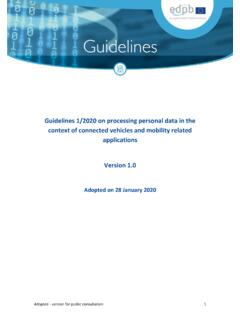Transcription of Innovations in Ethernet Encryption (802.1AE - MACsec) for ...
1 2016 Cisco and/or its affiliates. All rights reserved. This document is Cisco Public Information. Page 1 of 22 White Paper Authors Craig Hill Distinguished Systems Engineer Federal Area Stephen Orr Distinguished Systems Engineer Public Sector Innovations in Ethernet Encryption ( - MACsec) for Securing High Speed (1-100GE) WAN Deployments Introduction Over the course of the past decade, customer demand for increasing Wide Area Network (WAN) bandwidth has been driving the networking industry to continually innovate in order to increase WAN transport speeds.
2 Thus, we have witnessed the evolution from Asynchronous Transport Mode (ATM) to Synchronous optical Network (SONET)/Synchronous Digital Hierarchy (SDH) and, more recently, Innovations in Ethernet and optical . Ethernet and optical have now emerged as the de facto standards and we have seen speeds grow from 10-Gb, 40-Gb, and now to 100-Gb speeds with no end of growth in sight. Demand for increased bandwidth continues, driven by cloud services, mobile devices, and massive increases in video traffic. With the shift to cloud and mobile services, the need for ever-faster WAN transport speeds continues in order to handle the traffic created by locating applications and data off-premises.
3 While link speeds and demand for bandwidth continue to increase, the innovation of Encryption technologies for securing these high-speed links, specifically for the service providers, cloud providers, large enterprises and governments, has failed to keep up. Furthermore, customers want to simplify their network operations and reduce the amount of protocol layers and complexity they are implementing in these high-speed networks, including the recent interest to hide network layer information in transit (IP addresses and protocol port numbers).
4 This document provides an in-depth look into: How Cisco is addressing this dilemma of link speed bandwidth outpacing the Encryption technologies currently available Encryption Innovations led by Cisco, including a detailed introduction to WAN Media Access Control Security (MACsec) How Cisco is giving the 10-year old MACsec standard a technology face lift and innovating to meet the new customer demands for high-speed WAN Encryption (1G 100G+) for WAN data center interconnect, branch back-haul, and Metro Ethernet Detailed use cases and analyses from the perspective of enterprise customers as well as service providers offering transport services (Metro Ethernet , IP/Multiprotocol Label Switching [MPLS], as well as cloud service providers) A comparison of MACsec and IPsec, but also how each technology complements the overall Cisco Encryption solution portfolio and, in some cases, can be combined 2016 Cisco and/or its affiliates.
5 All rights reserved. This document is Cisco Public Information. Page 2 of 22 The Growing Interest in High Speed Encryption For many years, IP Security (IPsec) was synonymous with Encryption in the WAN, specifically over the Internet. It has been the dominant Encryption solution for customers back-hauling business traffic from remote and branch office locations, as well as being the Encryption choice of most Virtual Private Network (VPN) clients. IPsec is an Encryption solution operating at the IP layer of the Open Systems Interconnection (OSI) model and is flexible in that it can operate over any IP transport including private and public (Internet) transport.
6 Many large-scale IPsec deployments are currently in operation across enterprise and government networks today. IPsec has proven to be extremely flexible, transport agnostic, and capable of scaling to thousands of end devices. It is, however, proving to be more challenging from an overall throughput perspective for newer applications and cloud providers. Several shifts in new applications and the explosion of cloud are changing designs, including: Increasing bandwidth demands over the WAN for branch offices, application deliveries, video content distribution, and data center intraconnections.
7 Fewer applications are run locally in branch locations, and thus driving the need for higher speed transport. Highly resilient cloud computing architectures driving high-speed data center replication across geographically dispersed locations. Traffic pattern changes to a more any-to-any model, dictated by trends such as cloud, machine-to-machine (M2M) communications, and the Internet of Things (IoT) and Internet of Everything (IoE). Encryption landscape that is changing in the government (Commercial Solutions for Classified CSfC, transport security) that is driving the need for high-speed layered Encryption solution offerings.
8 As noted previously, cloud computing and new applications continue to emerge that are changing the traffic patterns of routed networks, as well as outpacing the Encryption rates traditional IPsec can support. As shown in Figure 1, using IPsec as an example, the Encryption performance capabilities are no longer aligned with links speeds as the links move to 40/100G and beyond. For example, some of the higher performing IPsec engines in routers today target approximately 75-Gbps IPsec performance, unidirectional flow, at 1400-byte packet sizes.
9 As the applications require bi-directional flow patterns, that number gets cut in half to approximately 37 Gbps. Then, introduce Internet Mix (IMIX) traffic patterns or smaller packet sizes based on the application being encrypted, and the overall IPsec performance drops further. 2016 Cisco and/or its affiliates. All rights reserved. This document is Cisco Public Information. Page 3 of 22 Figure 1. Link Speeds Outpacing IP Encryption Example with Cisco ESP-200 Furthermore, if the deployment requires that all traffic leaving/traversing the router must be encrypted, the overall throughput of the router is now restricted to the performance of the IPsec engine which, in most cases, can be a fraction of the router s aggregate forwarding capabilities.
10 This is a huge factor from an economics perspective of cost per bit through the router and MACsec changes the Encryption cost per bit through routing elements. For deployments requiring Encryption and the capability of leveraging an Ethernet transport (public or private), MACsec offers a simplified, line-rate, per port Encryption option for secure next-generation deployments. As shown in Figure 2, MACsec, as the name implies, is MAC layer or link layer Encryption and offers Encryption equal to that of the Ethernet port rates (1/10/40/100 Gbps) bidirectionally regardless of the packet size, executing the Encryption function in the physical layer (PHY) of the Ethernet port.












